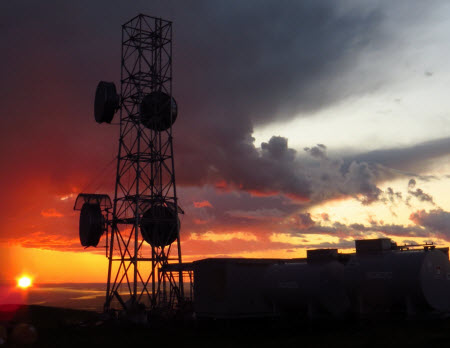Cable’s Last Frontier

Space may be the final frontier for sci-fi fans, but for cable operators, the last frontier lies square in the home territory of Anchorage-based General Communication Inc.
No marathon of Ice Road Truckers or Alaskan Bush People can prepare even grizzled cable veterans for Alaska’s harsh climate and the rugged terrain of the cold and, some say, lonely state.
All this came into focus when GCI undertook its most ambitious construction project to date — a 10-year sojourn to bring a hybrid terrestrial fiber and microwave based high-speed data network to all Alaskans, dubbed TERRA for Terrestrial for Every Rural Region in Alaska.
The project was spurred by $88 million in funding from the federal broadband stimulus program in 2010 (consisting of a $44 million grant and a $44 million loan). It subsequently grew to a $300 million undertaking, connecting rural customers to health care, educational and governmental services that would have literally taken days to access prior to the construction of the network.
Also: GCI Starts Down Video’s IP Pathway
Alaska is the least-dense state in the union: It has about 1.2 people per square mile, compared to 1,200 for the densest state, New Jersey. While that could present economic challenges, senior vice president of GCI Business Martin Cary, who was in charge of building the network, said that sense of sparseness could be a little misleading. Though small, he said, Alaskan villages are very highly concentrated.
The Long Middle Mile
“The great distances are between them,” Cary said. “Instead of the country road, where you have a house every four or five miles, these are villages of 100 to 1,000 people and the middle mile is the challenge.”
The biggest boost comes from the anchor tenants in each area, he said, hospitals and schools that are supported by the federal government’s Universal Service Fund to help pay the bills.
Even with that support, though, the actual construction of the network presents difficulties that the average cable operator can’t fathom.
For example, Cary said that most telecom networks follow the area’s highway system. Alaska has few highways, meaning that networks have to span huge tracts of open land. In addition, a large portion of the state consists of land owned and run by the U.S. Bureau of Land Management, which doesn’t give out permits to dig fiber trenches easily or often. In areas where telecom providers can dig, they have to be sensitive to native wildlife. And all of this must occur during an incredibly short building season. Alaskan summers are notoriously short, and only get shorter the further north you go.
“Everything in Alaska happens in the summer, including birds nesting,” Cary said. “Our permits are very much structured around the breeding habits of all of these animals. We can’t fly helicopters for certain months; we can’t disturb caribou. It really becomes a huge logistical challenge.”
Once those hurdles are cleared comes the challenge of working in the harshest climate in the country.
Braving the Elements
As part of the TERRA construction, workers had to install 22 mountaintop repeaters — essentially towers in remote areas that pass the microwave signal from one point to the next. One of the largest, the Harvey Repeater, sits atop a 2,400-foot mountain that is 400 miles from the nearest paved road. In the winter, they braved temperatures that could drop as low as minus-30 and minus-40 degrees.
GCI workers and contractors laid fiber across Lake Iliamna, the largest lake in Alaska, crossing inlets with 39-foot tides. “It’s like a river that runs both ways,” Cary said.
They hoisted 20,000-pound buildings up mountains using helicopters and sky cranes; they dealt with bears — brown bears apparently see fiber installations as play toys — and braved avalanches and long, cold nights. GCI, because of the harshness of the terrain and the unpredictability of the weather, builds camps at the job sites for workers, who usually stay for long stretches of time. But even the short jobs require that food, water and shelter be provided in the case of a freak storm or other unplanned event.
“You can easily go to a mountain top and the weather changes and have people stuck there for seven days,” Cary said.
GCI director of corporate communications Heather Handyside put it a little more bluntly.
“Have you ever interviewed anyone else who said, ‘One of our goals is to ensure our technicians survive?’ ” she asked.
It also means that GCI has to think of a lot of things other operators wouldn’t have to.
Cary pointed to part of the TERRA project that involved stringing fiber in a steep valley that was prone to avalanches. GCI came up with the idea of designing an aerial fiber run where the wires were loosely strung on poles that were placed far apart. In the case of an avalanche, the poles would snap but the fiber would flow with the snow. The idea was that there was enough slack in the cable to ensure its survival.
Said Cary, “So far, we’ve made it six years.”
Animals can be an obstacle, too. One day, a group of splicers came upon a vault near Prudhoe Bay that had been broken into by a large brown bear.
“He [the bear] had basically pulled the cable out of the vault and was running around playing with it,” Cary said. “We’ve had bears chew on cables in the southeast of Alaska. You just can’t leave anything exposed.”
But the benefits of TERRA far outweigh the hazards of building it.
Networks Save Lives
For some Alaskans, it means the difference between life and death. Cary noted that with the TERRA Network, a rural hospital can transfer an X-ray electronically to a hospital in Anchorage and receive a diagnosis in minutes. Before TERRA, that X-ray had to be loaded on a plane and flown to the bigger hospital, which could take days.
TERRA has also transformed the way rural schools teach students. In one remote community, the local high school only has 10 students with a handful of teachers teaching all subjects for all grades. TERRA allows them to offer courses via distance learning that may not have been possible.
While TERRA is bringing rural Alaska into the Internet Age, GCI has been offering high-speed data and business services to other, more-populated parts of the U.S. for decades. Business services, which make up about 55% of GCI’s total business, have expanded to the Pacific Northwest: GCI purchased a network engineering company, Northpoint Consulting, earlier this year and opened its Pacific Northwest headquarters in Seattle last summer. Today, GCI handles communications for the National Football League’s Seattle Seahawks and for Alaska Air. ▪️
Multichannel Newsletter
The smarter way to stay on top of the multichannel video marketplace. Sign up below.
